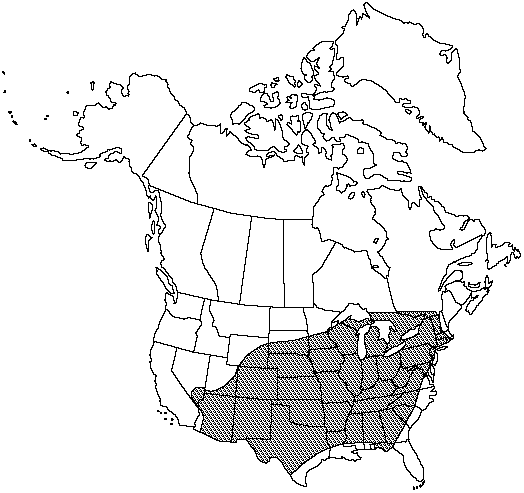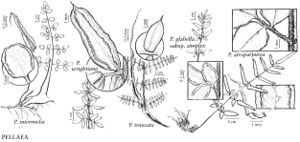Pellaea atropurpurea
Fil. Spec. 59. 1841.
Stems compact, ascending, stout, 5–10 mm diam.; scales uniformly reddish-brown (or tan), linear-subulate, 0.1–0.3 mm wide, thin, margins entire to denticulate. Leaves somewhat dimorphic, sterile leaves shorter and less divided than fertile leaves, clustered on stems, 5–50 cm; croziers villous. Petiole reddish purple to nearly black, lustrous, rounded adaxially, without prominent articulation lines. Blade elongate-deltate, usually 2-pinnate proximally, 2–18 cm wide; rachis reddish purple throughout, straight, rounded adaxially, densely pubescent adaxially with short, curly, appressed hairs. Pinnae perpendicular to rachis or ascending, not decurrent on rachis, usually with 3–15 ultimate segments; costae straight, 10–100 mm, often longer than ultimate segments. Ultimate segments linear-oblong, 10–75 mm, leathery, sparsely villous abaxially near midrib; margins weakly recurved to plane on fertile segments, usually covering less than 1/2 abaxial surface, borders whitish, crenulate; apex obtuse to slightly mucronate. Veins of ultimate segments obscure. Sporangia long-stalked, containing 32 spores, not intermixed with farina-producing glands. n = 2n = 87, apogamous.
Phenology: Sporulating summer–fall.
Habitat: Calcareous cliffs and rocky slopes, usually on limestone
Elevation: 100–2500 m
Distribution

Ont., Que., Ala., Ariz., Ark., Colo., Conn., D.C., Fla., Ga., Ill., Ind., Iowa, Kans., Ky., La., Md., Mass., Mich., Minn., Miss., Mo., Nebr., Nev., N.J., N.Mex., N.Y., N.C., Ohio, Okla., Pa., R.I., S.C., S.Dak., Tenn., Tex., Utah, Vt., Va., W.Va., Wis., Wyo., Mexico, Central America in Guatemala
Discussion
Contrary to D. B. Lellinger's (1985) hypothesis, isozyme data indicate that neither Pellaea glabella nor P. ternifolia was involved in the origin of this apogamous triploid. Instead, it appears that P. atropurpurea is an autopolyploid derivative of a single diploid taxon that has not yet been located. A thorough survey of spore number per sporangium in this species should be undertaken to determine whether the diploid progenitor is still extant. Collections from western Canada identified as P. atropurpurea actually represent P. gastonyi, an apogamous tetraploid produced by hybridization between P. atropurpurea and diploid populations of P. glabella. Pellaea atropurpurea has also hybridized with P. wrightiana; the hybrid is a rare apogamous pentaploid known only from western Oklahoma. Pellaea lyngholmii is the apogamous tetraploid hybrid between P. atropurpurea and P. truncata. Pellaea atropurpurea is distinguished from all these hybrids by having rachises that are densely pubescent adaxially, larger ultimate segments, and spores averaging less than 62 µm in diameter.
Selected References
None.
Lower Taxa
"thin" is not a number.
